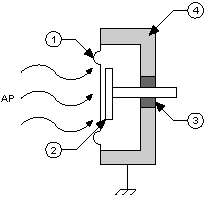Microphones
A microphone is a transducer that converts acoustical waves into electrical signals. The most common instrumentation microphone, a condenser microphone, uses a capacitive sensing element.
A condenser microphone incorporates a stretched metal diaphragm that forms one plate of a capacitor. A metal disk placed close to the diaphragm acts as a backplate. When a sound field excites the diaphragm, the capacitance between the two plates varies according to the variation in the sound pressure. A stable DC voltage is applied to the plates through a high resistance to keep electrical charges on the plate. The change in the capacitance generates an AC output proportional to the sound pressure. The following figure shows a condenser microphone.

AP = acoustic pressure, 1 = metal diaphragm, 2 = metal disk, 3 = insulator, 4 = case.
An instrumentation microphone usually consists of a microphone cartridge and a pre-amplifier. Sometimes these two components are independent; sometimes the components are combined and cannot be separated.
The major characteristics of a microphone are its sensitivity, usually expressed in mV/Pa, and its frequency response. Microphones are available in different diameters. Common diameters include: 1/8 in., 1/4 in., 1/2 in., and 1 in. Each diameter offers a specific compromise in terms of sensitivity and frequency response.
To reduce errors when using a microphone, keep several factors in mind:
- For measurements in a free field (a sound field with no major nearby reflections), use a free-field microphone pointed at the source of sound.
- For measurements in a diffuse field, such as inside in a highly reverberant room, where sound is coming from all directions, use a random incidence microphone.
- For measurements when the microphone is part of the surface of a room or of the object being measured, use a pressure microphone.
- For outdoor measurements, fit the microphone with suitable protection against the environment. This may include windscreens, rain caps, and built-in heaters to prevent condensation.
- To prevent vibrations from influencing the measurement, you might need to shock mount the microphone. Check the microphone specifications for vibration sensitivity.
- For reproducible measurements, make sure the microphone is mounted firmly and at a precisely reproducible location, both compared to the unit being tested and to the environment.
- Always calibrate the entire measurement chain, including the microphone, before starting the measurement. For highly critical measurements, as an extra precaution, you may want to perform a new calibration immediately after the measurements are completed to make sure the system is still within tolerances.